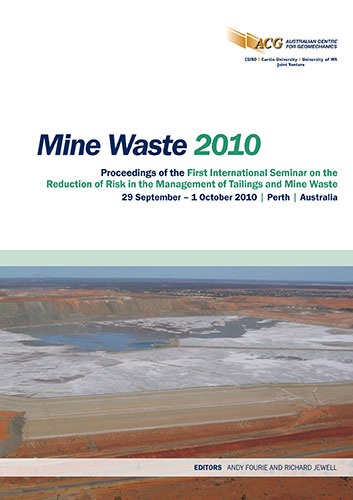Filtered tailings in Western Australian iron ore projects — comparison of filtered tailings with other tailings disposal methods

|
Authors: Hogg, CS |
DOI https://doi.org/10.36487/ACG_rep/1008_38_Hogg
Cite As:
Hogg, CS 2010, 'Filtered tailings in Western Australian iron ore projects — comparison of filtered tailings with other tailings disposal methods', in R Jewell & AB Fourie (eds), Mine Waste 2010: Proceedings of the First International Seminar on the Reduction of Risk in the Management of Tailings and Mine Waste, Australian Centre for Geomechanics, Perth, pp. 463-472, https://doi.org/10.36487/ACG_rep/1008_38_Hogg
Abstract:
The opportunity to utilise innovative techniques to improve mining project outcomes is now more favourably viewed when conducting feasibility studies. One option that has been studied is the use of filtered tailings with the tailings being disposed in an integrated waste landform, i.e. allowing a form of co-disposal. The tailings are de-watered using a filter system and delivered to the tailings storage site via a truck operation or utilising conveyor systems. De-watering the tailings in the plant to produce filtered tailings, at around 80% solids, reduces water consumption for the project. Another advantage of filtered tailings is the placement of tailings at higher density allowing smaller disposal footprint areas when compared with more traditional options. This paper presents a case study including financial analyses and compares filtered tailings and thickened tailings options. One of the main aspects investigated by this paper is water conservation and the cost of water.
References:
Access Mining Consultants Ltd (2003) Examination of Revegetation Methodologies for Dry Stack Tailings in Northern
Environments, Mining Environmental Research Group, Government of Yukon, pp. 3–4.
Coffey Mining (2008) Balla Balla Magnetite Project, Conceptual Design of Tailings Storage Facility, Coffey Mining
Report.
Condon, P. and Lear, K. (2006) Geochemical and Geotechnical Characteristics of Filter-Pressed Tailings at The Greens
Creek Mine Admiralty Island, Alaska, in Proceedings 7th International Conference on Acid Rock Drainage,
March 26–30, 2006, St Louis, USA, pp. 350–363.
Copeland, A. and van Greunen, P. (2006) Disposal of Belt Filtered Tailings – Skorpion Zinc Case Study: Feasibility,
Design and Early Operation, Australian Centre for Geomechanics, Perth, Australia, pp. 243–254.
Lane, J.C. (2007) Case histories of integrated waste landforms and in-pit deposition; what are the costs of these
options?, Total Tailings Management Seminar Notes, Section 10, December 5–7, 2007, Perth Western Australia,
Australian Centre for Geomechanics, Perth, Australia, 14 p.
Minson, D.N. and Herrera, R. (2004) Filtering Systems for Dry Tailings Deposition, Solid – Liquid Separation 04,
November 8–9, 2004, Cape Town, South Africa, Minerals Engineering International, 14 p.
© Copyright 2025, Australian Centre for Geomechanics (ACG), The University of Western Australia. All rights reserved.
View copyright/legal information
Please direct any queries or error reports to repository-acg@uwa.edu.au
View copyright/legal information
Please direct any queries or error reports to repository-acg@uwa.edu.au